
Pre Wedding Phase
Wedding Day Phase
Post Wedding Phase
The wedding celebration usually takes place on Sunday and involves
two parts: the church wedding ceremony [vinchannia] and the traditional
celebrations at the homes [vesillia]. The church service serves as the legal
sanction for the union, however in the community's opinion, perhaps the most
important part of the wedding occurs after the church service, during the
vesillia at the bride's house.
The unplaiting of the braid [rozpletyny]
The first rite of preparation on Sunday morning is the unplaiting of the
bride's braid. She is seated on a bench, which is covered with a pillow. After
the starosty bless her, the bridesmaids or the bride's brother comb her hair
and sing ritual songs. After the bride's hair is combed, the bride's hair is
braided again in a special way and placed on her head in the form of a wreath.
 Dressing
[uberanniia] Dressing
[uberanniia]
Once the ceremony of the unplaiting of the braid is completed, the bride is
dressed in her wedding clothes. Her costume includes a pair of boots, which she
received from the groom as a gift the day before the wedding. She also receives
the wreath made during the wreath-weaving ceremony. The bride then waits for
the arrival of the groom and his party. The groom's wedding attire includes an
embroidered shirt that had been given to him by the bride as a pre-wedding gift.
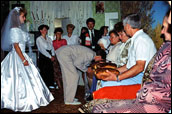 Blessing
[blahoslovennia] Blessing
[blahoslovennia]
This is the ritual blessing of the bride and groom by their parents. It usually
takes place shortly before the wedding ceremony. It may be done separately for
the bride at the home of her parents and for the groom at the home of his
parents, or it may be combined. In a combined blessing ceremony, the starosta
first asks the 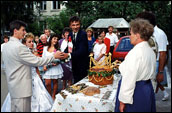 couple's
parents to sit on benches. Once seated, a long embroidered cloth, rushnyk is
placed on their lap, and everyone is given a loaf of wedding bread. The
starosta recites a ceremonial text such as the following: "As these two
children stand before their own mother, before their own father, before
their uncles, before their godparents; maybe they did not listen to one
of you, I ask you to forgive them and bless them." In Ukrainian, the word
proschannia is used to describe forgiving someone of their offenses as well as
bidding them farewell. Then the family members repeat "Bih sviatyi" ([May] Holy
God [forgive and bless you]) three times. The couple then bows to their parents
and kisses their faces, hands, and feet. This blessing is performed three times. couple's
parents to sit on benches. Once seated, a long embroidered cloth, rushnyk is
placed on their lap, and everyone is given a loaf of wedding bread. The
starosta recites a ceremonial text such as the following: "As these two
children stand before their own mother, before their own father, before
their uncles, before their godparents; maybe they did not listen to one
of you, I ask you to forgive them and bless them." In Ukrainian, the word
proschannia is used to describe forgiving someone of their offenses as well as
bidding them farewell. Then the family members repeat "Bih sviatyi" ([May] Holy
God [forgive and bless you]) three times. The couple then bows to their parents
and kisses their faces, hands, and feet. This blessing is performed three times.
 Wedding
procession [pokhid] Wedding
procession [pokhid]
The bride and groom may go to the church together or, in some regions, in
separate processions each from their own home. The bride and groom may walk,
ride on wagons, or go by horseback, depending on the local tradition and
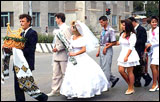 the distance to the church. On the way to the church, musicians play music and
the entourage sings until the group reaches the church.
the distance to the church. On the way to the church, musicians play music and
the entourage sings until the group reaches the church.
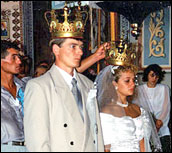 Church
marriage ceremony [vinchannia] Church
marriage ceremony [vinchannia]
When the bride and groom arrive at the church, they enter the church together.
It is said that the one who steps into the church first will have the first and
last word in the family's affairs. The priest blesses the couple in the rear of
the church and leads them to the centre table [tetrapod] for the ceremony.
During the church ceremony, the groom's senior best man holds a candle for the
groom and the bridesmaid holds a  candle for the bride. It is said that the couple will have a happy life
together only if the candles burn brightly. The priest crowns the couple, and
they walk around the tetrapod three times.
candle for the bride. It is said that the couple will have a happy life
together only if the candles burn brightly. The priest crowns the couple, and
they walk around the tetrapod three times.
Throwing grains
After the church ceremony, the bride and groom each return to their respective
homes. The bride's procession returns to the bride's home in the same order as
it left. Her parents and guests welcome the bride by sprinkling her with
grain - a symbol of fertility. The groom is welcomed in similar fashion at his
own home.
Celebrations
The wedding celebrations take place in both the bride's family's and the
groom's family's houses. All participants are served with a generous meal. The
guests celebrate the wedding, toasting and dancing.
The wedding train [poizd]
After a time, the groom prepares his best men and other attendants to travel to
the vesillia at the bride's house. The members of the group depart after a
blessing by the groom's parents.
Interception [pereima] and Fight [bii]
Once the groom and his group depart for the vesillia at the bride's house, the
young men of the bride's neighbourhood or village bar the groom's passage and
ask him to pay a "treat and ransom." The groom may meet such a barrier several
times. Only after negotiations or a ritual "fight" [bii] is the groom allowed
to enter the bride's house. At this point, the bride is seated in the posad,
her head bowed forward onto the table and covered with a kerchief. The groom
must again symbolically pay for the bride and fight off her brothers before he
can sit next to her behind the table, remove the kerchief from her head, and
kiss her.
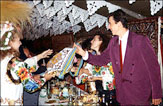 The
presentation of gifts [darovannia] The
presentation of gifts [darovannia]
The families of the bride and groom exchange gifts. In some regions, the
groom's svakhy and his best man distribute the gifts to the bride's family. The
best man calls out the recipient's name and the person steps forward to accept
the gift. The bride's mother sometimes receives boots, which she lifts into the
air to display. She puts them on, dances in them and sings. After the gifts
from the groom's family have been distributed, the bride's family presents the
groom's family with embroidered rushnyky. The bride's mother gives all the
rushnyky to the best man. He calls out the recipient's name and presents him or
her with the rushnyk.
The distribution of the korovai
After the starosta blesses the main wedding bread, the groom's senior best man
cuts it and passes the pieces to his assistant, who places each piece on a
plate. The bride and the groom each receive a piece of bread first and then the
bride's parents are served. All members of both families and all the wedding
guests then share this special offering as a symbol of their union.The
assistant calls out each recipient's name and gives them their piece of
korovai. The recipient presents a small monetary gift to the couple.
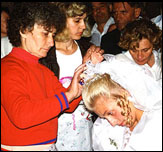 Covering
of the bride's head [vkryttia molodoi] Covering
of the bride's head [vkryttia molodoi]
In a special ceremony, the bride's wedding headpiece is removed, and a kerchief
is placed on her head. This act symbolically incorporates her into the
community of married women.
Supper [vecheria]
After the covering of the bride's head, another major meal is served. The
starosta blesses the 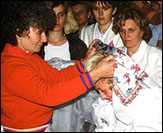 food,
and then the wedding guests are seated and served various dishes and drinks. food,
and then the wedding guests are seated and served various dishes and drinks.
The couple's departure
After the supper, the bride says farewell to her friends and parents. To the
accompaniment of songs and music, she departs with the groom's party for his
family's home. They take her dowry and belongings with her.
The arrival at the groom's home
When the bride and groom and their entourage reach his house, the groom's
parents greet them. While the groom's father holds bread and salt, his mother,
wearing her sheepskin coat inside out, holds a kerchief and grain. After the
couple bows before the parents, the father blesses the newlyweds and the mother
sprinkles grain behind them. Following the blessing of the couple, celebrations
in the groom's house [vesillia u molodoho] intensify. Another meal is served
for the couple and guests.
 The
nuptial bed in a storeroom [komora] The
nuptial bed in a storeroom [komora]
After the supper, the vesillia ends with the rite of komora, where the nuptial
bed has been prepared on straw and a sheepskin coat. A sheaf of rye and a holy
ikon is placed at the bed's head. While the bride and groom spend the first
night together in the komora, the remaining guests continue celebrating with
music, food, drinking and dancing.
|




